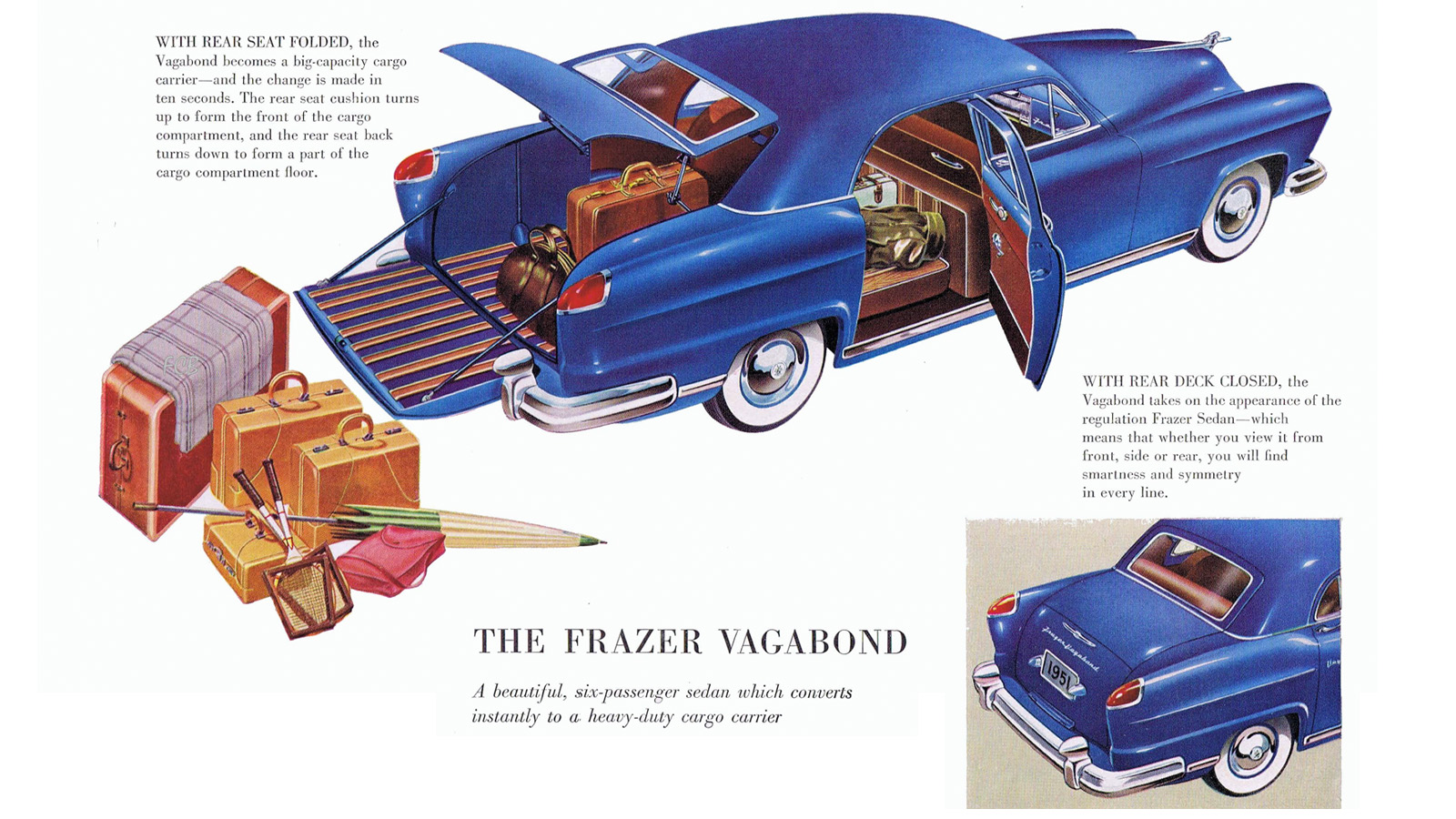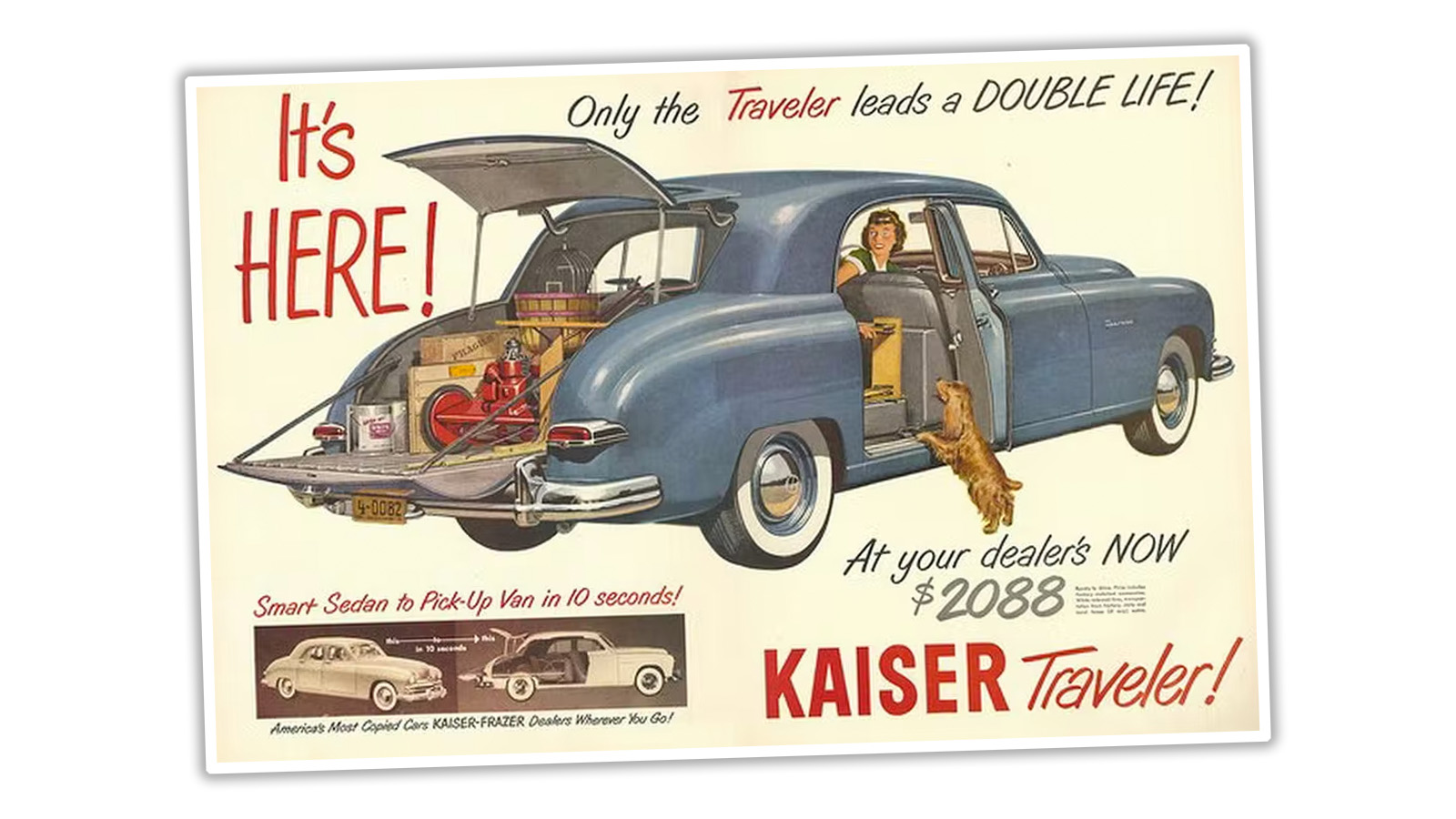Before we get to. the Vagabond, I just wanted you to consider some of the cars I mentioned and am showing you above as continuations of the Vagabond’s legacy; cars that are shapeshifters, transformers that can adapt, physically, to a variety of different jobs. Hell, we even saw Audi introduce a concept car with this sort of idea just this week! Also, since I mentioned the Toyota bB Open Deck, I’m going to make you watch this bonkers commercial for that car, which is full of mermen:
Okay, now that we have mermen out of our systems, we can talk about the Frazer Vagabond, and its badge-engineered brother, the Kaiser Traveler. If the Kaiser-Frazer name is unfamiliar to you, that’s not really surprising. The company was only around from 1947 to 1953, started by industrialist Henry J. Kaiser (who named this car after himself) and Joseph Frazer, who worked at executive-level positions for a number of carmakers. In 1953, the company bought Willys-Overland, and became Kaiser-Willys Corporation, and then became Kaiser Jeep in 1963. I don’t want to get too deep into Kaiser-Frazer history here, though, because the specific Kaiser-Frazer I want to talk about is just too damn interesting. The Frazer Vagabond/Kaiser Traveler were built from 1949 to 1951 and were designed to be comfortable six-passenger sedans that could convert into what is essentially a pickup truck. And, unlike a lot of modern SUVs with hatches and folding seats, the Vagabond/Traveler wasn’t just playing around about this truck business, they meant it, with load space comparable to a pickup and access nearly as good. Plus a wood-slat-covered load bed! You can tell that Kaiser-Frazer wasn’t playing around here, because they showed these things hauling fucking livestock in their ads:
Oh, your RAV4 has a folding rear seat? Your Tesla Model X is quite roomy? Great, want to shove a cow or horse in there? Yeah, didn’t think so. These cars had some of the very earliest hatchbacks (not the first, though; I think the Citroën Traction Avant Commerciale from 1936 takes that prize) and also had a fold-flat long tailgate and a folding rear seat that formed the cargo area front bulkhead. I mean, just look at this:
See how the rear seat acts to protect the back of the front seats? Look how long that load bed is! And, when it’s all buttoned back up, it’s amazing how you would never guess that this tidy sedan is capable of such workhorse feats. It’s kind of like the shock you may have experienced when it was revealed that under that frumpy green sweater, Ned Flanders was ripped. The two looks just don’t seem to be able to exist in the same entity, and yet here they are.
According to this press photo from 1949, the load bed there is ten feet long. Just for perspective, a Ford F-150 bed can be as short as 5.5 feet long, just over half the length of the Traveler/Vagabond. Damn. Let’s just look at this in a diagram:
Amazing, right? I think so. Just look how much that jelly-mold body opens up, and even with the back seat up, so you can seat six, you’d still have a bed about as long as that F-150.
Oh! Another nice detail: like the original Mini, the license plate and lights would hinge to be visible even with the tailgate down, as you can see above there. I always liked that idea.
Even the price was pretty reasonable; $2,088 in 1950 comes to about $25,000 in today’s money, and I think that’s very decent for what has the best claim to be two vehicles in one of almost anything else I can think of. Why something like this hasn’t made a modern comeback is baffling. EVs are the perfect platform for this kind of thing, with their flat skateboard chassis. You could have a boxy SUV with a genuinely rugged rear interior lining, and maybe make a short rear hatch that can flip completely flat onto the roof, a nice big tailgate that extends the load area, and have something that can actually transform into a pickup-like vehicle when needed. You know, kind of like what Audi just showed:
Now, someone just needs to make this idea real again, not just a concept. I love cars that seem eager to help you do all you can do with your life, and this design absolutely screams that. It’s literally transforming its body to meet your wide and varied transportation needs. There needs to be more of this thinking, even if it comes from a short-lived automaker hardly anyone thinks about today. Except, of course, for today.
Under-Appreciated Clever Innovations: The Škoda Felicia Fun’s Secret Sliding Supplemental Seat System Setup This Is The New GMC Sierra EV, Which Will Start Around $50,000 After Launching As A $108,000 Pickup With Over 750 HP, 400 Miles Of Range, And A Midgate Kaiser Darrin, TVR Griffith, Fiat Panda 4×4 Sisley: Mercedes’ Marketplace Madness Got a hot tip? Send it to us here. Or check out the stories on our homepage. This is because in order to make a continuous flat cargo area they had to relocate the spare tire, and to do this they stripped the left rear door of its upholstery and interior handle, shoved the spare tire in it, and welded the door shut, but kept the exterior handle for the sake of symmetry. When the Kaiser Traveler was redesigned in 1952, they made sure to leave room under the cargo area for the spare tire so that all four doors could be used, but until then if you were unfamiliar with the Traveler/Vagabond and tried to get into the car via the back left door, you’d be met with frustration and laughter from the car’s owner 🙂 “You can live in you car, but you can’t drive your house….” Passing the miles of barbed wire and occasional jack rabbit, you see a herd of wild horses crossing the road ahead. You slow, but one of the surprisingly white, almost glowing horses gets its leg caught jumping the fence. You’ve always been good with animals, being a champion corgi jockey, so you pull over to see if there’s anything you can do. To your shock, the horse has already freed itself, but is bleeding silver blood all over. Also, it has a horn. “Please”, it begs you in a magical unicorn voice that sounds like Sting, “I’m weakened. I need water, salt, and a mix of organ meat juices if I’m to catch back up with the herd. Do you have anything like that?” Your thoughts drifting to the bottoms of all those thawing cases of hot dogs, you tell it, yes, yes you do… Incredibly grateful for your help and for the finest hotdog water it has ever tasted, the magical creature gives you two choices: You may drive your car through the unicorn blood that’s now all over the ground. So long as the seats stay damp with hotdog juice (to keep the unicorn blood happy) you will next need another set of tires again. You can do all the burn outs, all the drifting, all the off roading you want, you’ll never have a blow out and the tires will work like new. The magic even moves to a new car if you buy one, due to something to do with warranty transfers. There are no limits, you can go racing if you want, though the good folks at Formula 1 will certainly ask a lot of awkward questions if you do. However, if your seats ever dry, the magic is gone forever. Option 2, you may drink the blood. You will acquire the driving skills of our dear departed Ken Block. You are free to use them however you see fit, rallying, hooning, making YouTube, whatever. However, much like the car tire dilemma, you must keep the unicorn blood now inhabiting your body happy, and it only likes one thing- hot dogs and hot dog water. If you ever eat anything else, the driving skills will be gone. The unicorn blood does not protect your normal human body from the ravages of excess sodium and preservatives, nor the dearth of basic vitamins. Buns, ketchup, and all other manner of toppings are not allowed, this might give you scurvy if it goes on long. So, what’s it going to be? Damp, smelly car with perfect tires forever, or fame, fortune, and misery?









